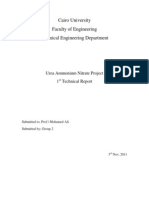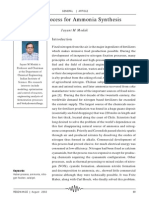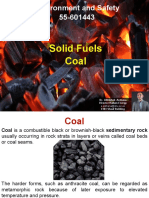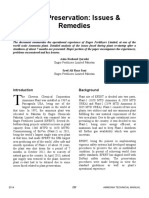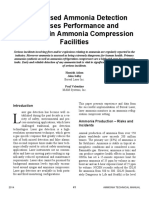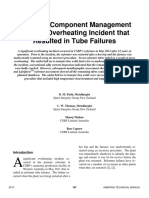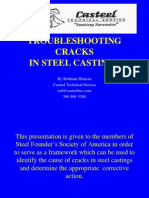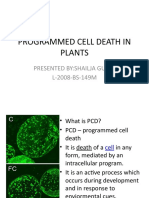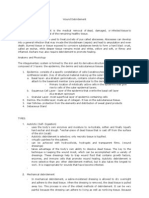Ammonia Production - A Century of Safety, Health & Environmental Improvements
Ammonia Production - A Century of Safety, Health & Environmental Improvements
Uploaded by
GrootCopyright:
Available Formats
Ammonia Production - A Century of Safety, Health & Environmental Improvements
Ammonia Production - A Century of Safety, Health & Environmental Improvements
Uploaded by
GrootOriginal Title
Copyright
Available Formats
Share this document
Did you find this document useful?
Is this content inappropriate?
Copyright:
Available Formats
Ammonia Production - A Century of Safety, Health & Environmental Improvements
Ammonia Production - A Century of Safety, Health & Environmental Improvements
Uploaded by
GrootCopyright:
Available Formats
Ammonia Production - A Century of
Safety, Health & Environmental
Improvements
The development of the remarkable iron catalyst by Alwin Mittasch and the technology for the
synthesis of ammonia from nitrogen and hydrogen by Fritz Haber and Carl Bosch lead to BASF
starting to operate the world’s first ammonia synthesis plant in 1913.
Using a perspective on the history of operations at Billingham, UK and technologies pioneered there,
this paper discusses the development of ammonia production over the subsequent years to the present
day. Specific references are made to the technical improvements and changes to the process that
have contributed to greatly improved safety, health and environmental impacts in the process of
ammonia synthesis.
John Brightling
Johnson Matthey
John Pach
Johnson Matthey
Wheat Problem” as foretold by Sir William
Crookes in 1898 whereby a shortage of
Introduction available reserves (of wheat) would only allow
the world’s population to continue to expand to
A
mmonia is one of the most important
chemicals produced globally with about two billion, which would be reached
approximately 85% being used as around 1930. Thus, in the early 20th Century, the
fertilizer for food production. need to increase food production led to the
Ammonia synthesis from atmospheric nitrogen development of the fertilizer industry.
was made possible in the first part of the 20th
century by the development of the Haber-Bosch Today, the global value of ammonia production
process. It remains the only chemical is estimated to be over $100 billion (USD), with
breakthrough recognized by two Nobel prizes individual plants being capable of producing
for chemistry, awarded to Fritz Haber in 1918 3300 MTPD (3640 STPD). To achieve this
and to Carl Bosch in 1931. The development of scale, many improvements have been made over
ammonia synthesis directly addressed “The the last 100 years in both process and catalyst
2013 231 AMMONIA TECHNICAL MANUAL
technology. This paper aims to review this
history with particular reference to Billingham,
UK, where commercial ammonia production
was established in the 1920’s and where a
number of key process innovations have arisen.
Beginnings
An ammonia factory being located at
Billingham grew out of the needs of World War
I - after a shortage of munitions led directly to
the failure of the British offensive at Neuve
Chapelle in March 1915. The Minster of
Munitions at the time (later Prime Minister)
Lloyd George called it “the Great Shell
Scandal”. Britain was not producing enough
nitrate based explosives. At that time natural
nitrates imported from Chile were the only
source Britain had, and the shipping supply
chain was suffering attacks by German U-boats.
As we know, by 1913, BASF had already been Figure 1. For Sale “The Times” 19th Nov 1919
synthesizing ammonia on an industrial scale,
thus throughout World War I Germany had a A member of a syndicate of interested parties,
local source of the key raw material for Johnson Matthey & Co, was a prospective buyer
explosives. as they were already involved in selling Pt/Ph
gauzes for use in the process but they were not
This problem led to the British Government successful (it was not until 2002 that Johnson
setting up an organization to develop technology Matthey finally acquired Billingham’s process
to produce synthetic ammonia, and this and catalyst expertise). In April 1920 the
organization chose Billingham as the site for the Government Nitrate Factory was taken over by
new development. The site was chosen due to Brunner Mond, which became part of Imperial
the ready availability of key raw materials (coal Chemical Industries (ICI) in 1926. By then the
and water) and skilled labour (shipbuilding and factory had been converted to make ammonia-
steel industries). By the time the plant (known based fertilizers and was renamed the Synthetic
as the Government Nitrate Factory) was Ammonia & Nitrates Division.
completed, World War I was over and the
government was in post-war debt. As a result,
the site was put up for sale in 1919 in a wave of
1920-1930’s Technology – Coke
privatizations (Figure 1 & Reference 1). Ovens
Before the first ammonia production plant was
built at Billingham, semi-tech plants were
developed by Brunner Mond at Runcorn
Cheshire at 3 and 5 MTPD outputs. The first
Billingham plant was a 24 MTPD (26 STPD)
unit that made its first ammonia in December
1924.
AMMONIA TECHNICAL MANUAL 232 2013
The ammonia plants built at Billingham in the the actual use of coke feed was about double the
1920’s and 30’s employed the classic Haber- theoretical use of 0.9 tons coke/ton ammonia.
Bosch process based on coke. The original The plant was also heavy, voluminous, high in
process is shown in Figure 2. maintenance needs and not kind to the
environment. Figure 3 shows the coke ovens
and water gas plant.
Figure 2. Original flowsheet for ammonia Figure 3. Coke ovens and water gas plant
production at Billingham
Using this technology the rise in output from the
The first stages of gas production were at site is shown in the Table 1.
atmospheric pressure. Alternate streams of
steam and then air were fed into gas generators Year Ammonia Plant
containing hot coke to make “water-gas” (H2 1924 24 MTPD No2 Unit
rich) and producer gas (N2 rich). These streams 1926 52 MTPD No2 Unit Extension
were purified using iron oxides to remove H2S 1928 170 MTPD No3 Unit
1929 373 MTPD Nos 4 and 5 units
and a shift converter to convert most of the CO 1932 415 MTPD Extension
to CO2 and H2. The “catalysed gas” was 1941 642 MTPD Process improvement
compressed first to 11 bar (160 psi) in rotary 1951 746 MTPD Converter internals redesign
compressors and then to 55 bar (810 psi) in Table 1. Ammonia output at Billingham from
reciprocating compressors. CO2 was removed 1924 to 1951
by counter-current scrubbing with circulating
water and the scrubbed gas was further As well as scale improvements there were
compressed to 250 bar (3670 psi), washed with improvements in effectiveness. In 1929, A.H.
copper liquor to remove residual CO and CO2 Cowap, chief engineer, noted “a striking feature
and then fed as make-up gas to the synthesis is an ever increasing rapidity of work. The first
loop. large unit, No 3 Unit, cost £5,250,000 and was
completed in 27 months (of which 7 months was
This production of syngas feed by a low- a labour stoppage for a coal strike). No 4 and
pressure process based on coke was excessively No 5 units cost £11M and have been completed
expensive. Cyclic water-gas process are in 2 months.”
fundamentally inefficient as much heat is lost in
blow gas and due to incomplete combustion – Despite improvements, by the late 1950’s,
increasing costs of coal and the intrinsic
2013 233 AMMONIA TECHNICAL MANUAL
inefficiency of syngas generation from coke had time steam reforming technology development
made this process uncompetitive. had advanced sufficiently to make it a more
competitive route for syngas production.
1950’s Technology – Partial
Oxidation Process
In 1954 Texaco (and subsequently Shell in
1956) developed a process for partial oxidation
of hydrocarbons which offered improved
economics. The partial oxidation process
reduced both the capital and operating costs of
low pressure gas generation, eliminated the need
for low pressure compression and offered
greater feedstock flexibility. The principle
disadvantage of the process was its requirement
for an air separation plant to supply oxygen. In Figure 4. Air separation plant explosion 1959
these early days the challenges for safe
operation and engineering of these air separation
units were significant. Frequent explosions in Steam Reforming of Light
oxygen plants encouraged engineers to meet and Naphthas
share information with the very first symposium
to discuss safety in air and ammonia plants, Steam reforming of hydrocarbons provides the
"Safe Design and Operation of Low most economic source of gas for ammonia
Temperature Air Separation Plants" held in synthesis. The general reaction is shown below.
1955 in Boston, USA.
CnH2n+2 + nH2O nCO + (2n+1) H2
Billingham commissioned a Texaco gasification
unit for heavy fuel oil, which was later The reaction was known to proceed at 700-
converted for naphtha feed. Syngas was 800 °C (1292-1470 °F) over a promoted and
produced at 30 bar (440 psi) pressure by supported nickel catalyst. ICI were pioneers in
reaction of the hydrocarbon with steam and a methane steam reforming in 1928 with
limited supply of oxygen at 1500 °C (2732 °F). commercial units having been built at
The syngas contained a little residual carbon Billingham in 1936 to reform propane/butane
and all the sulphur as H2S. After shift byproducts of hydrogenation of coal as part of
conversion, purification using carbon and CO2 synthetic hydrocarbons production (Oil Works)
removal with circulating hot potassium shown in Figure 5.
carbonate (Benfield) was employed. The
partially purified gas was compressed to 250 bar
(3670 psi) and added to the existing synthesis
plant before CO removal (copper liquor).
Unfortunately a serious explosion occurred
during the commissioning of the air separation
unit in 1959, which resulted in three fatalities
(Figure 4 & Reference 2). This incident
resulted in a long delay in the partial oxidation
plant achieving beneficial operation, by which
AMMONIA TECHNICAL MANUAL 234 2013
the development of new types of alkalized
catalysts.
Due to equilibrium considerations, to achieve a
low CH4 slip, a temperature of around 1000 °C
(1830 °F) is required, however the metallurgical
limit for a 10 year life of the available material,
25:20 Cr-Ni tubes, was a design exit
temperature of 800 ºC (1470 ºF). To overcome
this constraint the new steam reforming process
adopted two reforming stages, as shown in
Figure 6 (Reference 4). Now familiar to us as
primary and secondary reformers, these unit
operations are still present in nearly all
ammonia plants.
Figure 5. Cross section of 1936 Billingham
reformer
In the late 1950’s it became clear that ammonia
production based on coal could no longer be
economic. At this time natural gas was not
available in the UK (discovery and exploitation
of North Sea gas was still some 15-20 years Figure 6. Two stage (primary-secondary)
distant), however increasing quantities of light reforming
distillate hydrocarbons were available at falling
prices. Sulphur-free distillate hydrocarbons had
been successfully reformed by the catalyst 1960’s Steam Reforming
research group at Billingham in 1938 at Modernization
atmospheric pressure. What was needed was
the development of the process to operate at Having developed a viable steam reforming
higher pressures to avoid compression costs. process, the ammonia units at Billingham were
modernized with four steam reforming units
The world’s first pressurized steam reforming built in 1962-1963 (Figure 7). Each unit
process was designed at Billingham and was included a primary (tubular) reformer with
brought into commercial operation at Heysham 4 inch (100 mm) ID tubes and a reaction length
in 1962 (Reference 3). The main problems were of 20 ft (6 m). Operating at 14 bar (200 psi), the
adequate desulphurization of the feed, and reformed gas, containing 10-12% CH4, was
suppression of carbon deposition on the collected in headers near the ground and passed
reforming catalyst without the use of excessive to the air injection burner in the secondary
steam ratios. Desulphurization of the feed was reformer. After secondary reforming was waste
addressed by development of feed purification heat recovery, two stage CO shift, further heat
technology involving hydrogenation catalysts recovery, cooling and CO2 removal.
(Ni-Mo,Co-Mo) along with ZnO absorbents
capable of reducing sulphur to very low levels.
The problem of carbon formation was solved by
2013 235 AMMONIA TECHNICAL MANUAL
Benfield process (potassium carbonate) and
Vetrocoke (arsenious oxide) were adopted in
different Billingham plants in early 1960’s.
These processes achieved CO2 slips of <0.1%
dry.
Early 1960’s - Largest Single
Stream Plant
A “single stream” concept emerged for new
ammonia plants and Billingham engineers
Figure 7. World’s 1st four ammonia reformers designed and engineered a 360 MTPD
(400 STPD) “single stream” plant.
The process was rapidly adopted and by the Commissioned at Severnside in 1963, it was, at
mid-1960’s over 100 steam reforming process that time, the largest single stream ammonia
licences had been sold from Billingham to the plant in the world. The plant used the steam
following reputed engineering contractor naphtha reforming process, a hot potassium
licensors: Power Gas Corporation (later Davy), carbonate based CO2 removal system, a copper
Foster Wheeler, Selas, M W Kellogg (later liquor CO removal system, and had two HTS
KBR), Friedrich Uhde GmbH (ThyssenKrupp beds. Parallel reciprocating compressors driven
Uhde GmbH) and Humphreys & Glasgow by electric motors were used for synthesis gas
(Jacobs). compression.
CO2 Removal Modernization 1960’s New Shift Duty – Low
Temperature
Initially the syngas from the new reforming
units at Billingham joined the original plants at For coke-based syngas production, the high
the intermediate pressure compressors at 55 bar levels of sulphur present in syngas meant that
(810 psi) before CO2 removal. This the copper liquor process was effective in
configuration meant that 13 reciprocating achieving high purity syngas (low levels of CO
compressors, 28 CO2 removal towers, 18 water and CO2). The iron oxide shift conversion
pumps, 13 CO removal towers and 20 synthesis catalysts then in use were operating at >400 °C
converters were still in use. (>750 °F) giving an equilibrium CO conversion
of ~4.5% dry. Although more active copper-
The new steam reforming front end occupied an based catalysts were known to be able to
area of 14,160 m2 (3.5 acres) – a little less than accomplish the shift reaction at ~250 °C
10% of the area occupied by the coke-based (482 °F), they were very sensitive to poisoning
processes that it replaced. Using space freed up by sulphur and could not be used with syngas
by the reformers, improvements to the gas made from coke. The virtually sulphur free
purification and compression were introduced. syngas obtained from steam reforming allowed
As the existing CO2 removal process employed these copper-based shift catalysts to be used,
water washing at 55 bar (810 psi) and consumed achieving an equilibrium CO conversion of
0.75 GJ/tonne (0.78 MMBtu/ton); both capital ~0.2 mol% dry. ICI developed its own robust
and operating costs were high. As chemical and reactive Cu catalyst for this application.
absorbents with higher capacity for CO2
removal had become available, both the
AMMONIA TECHNICAL MANUAL 236 2013
Previously the copper liquor scrubbing had
reduced carbon oxides to a low enough level for
ammonia synthesis. However the combined low
level of residual carbon oxides from CO2
removal and CO shift was now such that they
could be made inert by methanation before the
synthesis loop, a concept patented by Edward
Maxted in England in 1918 (Reference 6).
As a result of all of the improvements
considered so far – steam reforming, shift, CO2
removal and methanation – by the mid-1960’s it
was possible to carry out all operations in single
stream reactors. The process flowsheet is Figure 9. Mid-1960’s final stage compressor
shown in Figure 8. efficiencies
This low efficiency was one of the reasons for
excluding centrifugal compressors for all but the
LP stages, and this reasoning still prevailed at
the beginning of the 1960’s.
Early 1960’s – a Second Plant for
Severnside
Attention then turned to a second plant for ICI
Severnside. This time the capacity would be
600 STPD (544 MTPD). Rather than design it
internally, a decision was made to solicit bids
from engineering contractors, one of which was
M.W. Kellogg. This activity led to what was
described as “possibly the most important event
Figure 8. Billingham flowsheet from mid- in the history of the development” of the single
1960’s stream ammonia plant (Reference 7). In late
1962, a meeting was held in which Ron Smith,
VP of Operations at M.W. Kellogg, opined that
Reciprocating versus Centrifugal the capacity of ammonia plants was bound to
Compressors increase and queried why the synthesis loop
pressure couldn’t be reduced from 325 bar
Early design memos for the Billingham plants in (4700 psi) to 150 bar (2200 psi), thus
the 1920’s had discussed the relative economics completely eliminating the need for
of reciprocating and centrifugal compression. reciprocating compressors. The resulting bid
They showed that the relative efficiency of for Severnside from M.W. Kellogg incorporated
rotary compressors for the later compression a number of important features:
stages would be low except at high throughputs, The steam naphtha reforming process.
shown in Figure 9. A loop pressure of 150 bar (2200 psi)
allowing the use of centrifugal compressors.
2013 237 AMMONIA TECHNICAL MANUAL
Improved plant efficiency by recovering
heat to generate high (for that time) pressure
superheated steam for use on steam turbine
drives – 62 bar (900 psi) and 450 °C
(850 °F) was selected due to a change in
specification at 62 bar (900 psi) and 482 °C
(900 °F) under ASME code.
The steam was generated at a higher
pressure than that required by the process, so
energy was recovered by expanding the
steam through turbines to the pressure level
required by the process.
At the end of the day, the contract was awarded Figure 10. Three M.W. Kellogg reformers
to a more conventional design from Bechtel.
Nevertheless, the basic principles of the M.W. When commissioned, the three plants suffered
Kellogg ammonia process had been born. from a variety of problems and initially were
very unreliable. This low reliability was
About 2 months later, M.W. Kellogg was attributed to a variety of reasons including the
invited for further discussions and asked how following:
large a plant could be built. The “1000 STPD”
The novel use of equipment such as high
plant had been born. In January 1964, M.W.
speed condensing turbine drives for process
Kellogg was awarded a contract for two plants
machinery.
to be built at Billingham. Within a few weeks a
UK taxation laws which discouraged steam
third plant was announced. With a capacity of
generation other than from coal, which
972 STPD (881 MTPD), they would be the
meant that the plants did not have an
largest plants ever built.
auxiliary boiler.
Further improvements were made to the design A change in mind-set was required. If you
offered for Severnside, and operating have a multi-stream plant with say ten units
information from the early 1970’s shows the in parallel, and you lose one of them you
Billingham plants with: still make 90% of what you intend to make,
so the upstream and downstream parts of the
31 bar (450 psi) reforming pressure
plant stay online. If you only have three
103.5 bar (1500 psi) HP steam pressure
single stream plants, and you lose a piece of
superheated to 450 °C (842 °F)
equipment in the middle of one of them, you
39 bar (560 psi) MP steam pressure can lose the entire plant and 33% of your
131 bar (1900 psi) loop pressure. production.
Mid 1960’s M.W. Kellogg Ammonia Catalyst technology and knowhow continued to
develop and it was noted that “It is important to
Units keep a constant level of mobile potash on the
As the M.W. Kellogg plants incorporated the surface of the catalyst to prevent carbon
steam naphtha reforming process, Billingham formation. The alkali must be released from the
engineers worked closely with their counterparts support in a controlled way to maintain the
from M.W. Kellogg in the design of the appropriate level of potash on the catalyst
reformers, shown in Figure 10. surface. A fine balance is required, since too
rapid removal of potash leads to short life,
AMMONIA TECHNICAL MANUAL 238 2013
whilst too slow a rate would lead to carbon The 1970’s at Billingham
laydown” (Reference 8). The practice of
installing different types of catalyst in a single The experiences of the 1960’s led to a more
reformer tube – more heavily alkalized at the conservative approach to plant design. This
top, lightly or un-alkalized at the bottom conservatism is illustrated by the fact that,
(double-decker) helped control potash migration although designed for 1100 STPD (998 MTPD),
as the potash was only present where it was Ammonia IV, commissioned in 1978 and shown
needed and could be captured before being in Figure 12, was able to achieve a throughput
eluted from the tube. of about 1350 STPD (1225 MTPD) without
substantive modification.
In the early 1970’s, the plants were converted to
run off a natural gas feed, with a propane
backup facility later being added. An on-going
problem with hot band formation led to the
development of more specialized catalysts,
suitable both for natural gases which contain
heavier hydrocarbons and for dual feed
applications.
1960’s Kanpur Ammonia Plants
In keeping with its status as an operator,
designer, technology licensor, and catalyst
manufacturer, ICI continued to develop its own
technology. Two Billingham designed
ammonia plants, constructed in Kanpur in 1969
featured the first application of ICI’s single
Figure 12. Ammonia IV (Ammonia 4)
nozzle secondary burner (Figure 11); the
forerunner of a design used in many ICI (and
subsequently Johnson Matthey) designed plants. The 1970’s – Process Safety
Developments continued, especially in the field
of process safety. A major milestone was the
introduction of the Hazard and Operability
Study. Before its introduction, safe operation
was often learned the hard way, by experiencing
fires, explosions and toxic releases, and learning
how to prevent them. The breakthrough was in
the recognition the answer to preventing process
accidents lay in the hands of the designer. Only
by critically examining and questioning the
design in detail could plants be made safer.
An ICI procedure, issued in 1972, required the
use of quantified risk assessment techniques
Figure 11. Single nozzle secondary burner both to confirm the adequacy of trip systems
and to calculate the frequency with which they
2013 239 AMMONIA TECHNICAL MANUAL
needed to be proof tested in order to maintain The 1970’s – Guard Catalysts
their integrity (Reference 9).
Before the effects of chlorine were recognized,
Arrangements were also made to allow the sulphur was thought to be the major cause of
plants to remain online whilst the trip systems LTS deactivation. Some companies tried to
were being proof-tested. Although there are address this by installing guard vessels or beds
some differences in terminology, the technique filled with zinc oxide. In some plants, however,
is similar to a SIL assessment, which only deactivation continued even after major
started to gain wide acceptance in the ammonia improvements to feedstock desulfurization
industry in the 2000s (Figure 13). (Reference 10).
In the 1970’s, it was recognized that
appropriately formulated LTS catalysts could be
self-guarding not only in regard to sulphur, but
also towards chloride. It was also recognized
that the benefits in terms of shift activity and
bed life accruing from the use of fresh LTS
catalyst outweighed the cost savings realized by
reusing discharged LTS catalyst. All LTS
catalysts subsequently developed by ICI and
Johnson Matthey were therefore optimized to
maximize their self-guarding capability.
Early 1980’s – The AMV Process
Ammonia technology continued to develop and
Billingham based engineers were tasked with
the design of a fifth ammonia plant for
Billingham (Ammonia V). Economic
considerations meant that capital cost had to be
reduced whilst improving plant efficiency.
Although market conditions in the early 1980’s
meant that the plant was never built at
Billingham, the designs for Ammonia V
evolved into the AMV process. The first AMV
design was commissioned at Courtright, Canada
in August 1985 (Figure 14). Ammonia
production was achieved 43 hours after feed gas
introduction – believed to be a record at that
Figure 13. Simplified analysis of high time (Reference 11).
temperature trip on air feed to a reformer
Following an explosion at Flixborough in 1974,
ICI’s HAZOP process (developed in the 1960’s)
was “donated” and rapidly became accepted by
the process industries as a best practice.
AMMONIA TECHNICAL MANUAL 240 2013
Mid-1980’s – The Leading Concept
Ammonia (LCA) Process
By the mid-1980’s, the two ammonia plants at
Severnside were becoming uncompetitive and a
decision had to be made – improve their
efficiency, replace them, or close the site.
Improving the efficiency wasn’t really an
option. New technology was developed at
Billingham to solve the problem.
The LCA process implemented at Severnside,
shown in Figure 15, used a combination of new
equipment, new catalysts, and improved
construction and procurement techniques, some
Figure 14. AMV process in Courtright of which are as follows:
first low temperature HDS (Hydro-
Features of the AMV process at the time desulphurization) KATALCOJM 61-2
included the following: first low temperature sulphur removal
ICI process design combined with Uhde absorbent PURASPECJM 2020
mechanical design first application of a process gas heated
electrically driven single casing syngas reformer
compressor isothermal shift catalyst – Catalyst 83-1
separate ammonia circulator specifically developed to resist the high
low pressure loop operating at about 85 bar operating temperature
(1230 psi) and featuring a new low pressure pressure Swing Absorption (PSA) for CO2
ammonia synthesis catalyst (KATALCOJM and nitrogen removal
74-1) which had been developed specially first low temperature methanation catalyst
for this project (KATALCOJM 11-4)
cryogenic hydrogen recovery unit low pressure ammonia syntheses using
recovering hydrogen to the circulator KATALCOJM74-1 – 80 bar (1160 psi),
suction which is even less than at Courtright
a real-time dynamic operator training modularized and prefabricated construction
simulator segregation of ammonia plant from utilities
dynamic simulation of the plant steam enabling “off the shelf” utilities to be
system conducted during the design process. purchased
use of Slamshut valves and instrumented
Operating with a low steam ratio, the plant was protection to reduce the size of the relief
one of the first to suffer from by-product system
formation and pressure drop increase due to low ammonia inventory
HTS over reduction. Copper was added to the
automated start up sequences, the most
HTS catalyst formulation to create an over
automated ammonia plant ever built
reduction resistant formulation, which was first
easy to start up – the second plant at
installed in 1987.
Severnside made ammonia only 19 hours
after natural gas was first introduced.
2013 241 AMMONIA TECHNICAL MANUAL
consequences of, loss of containment had not
been fully considered.
Following the fatal accident on the urea plant, a
small team met for five full days to review the
process safety in detail. A large number of
items, unrelated to the cause of the accident,
were raised by the study team.
This small multi-disciplinary working team
approach provided the pattern for developing a
Figure 15. LCA plants at Severnside streamlined technique - the Process Hazard
Review. This became the sixth stage of the ICI
6 stage Hazard Review Process and is similar in
1990’s – Process Safety Revisited concept to PHA promulgated under OSHA
With the advent of HAZOP and other process 1910.119, which came into force in 1992
safety techniques during the 1970’s and 1980’s, (Reference 13).
process accidents became less and less frequent
within the company. However, there was still 1990’s – Catalyst Developments
some concern that many older plants had not
been properly studied using HAZOP. Then, in Catalyst developments continued; Figure 16
1987 and 1989 two significant incidents took illustrates the dramatic improvement in the
place. First, the process conditions which activity of one particular catalyst, which
occurred during start up led to a failure, a brittle resulted from a combination of on-going
fracture, and a fire at the base of the flare stack development and the incorporation of learning
of the largest plant in the company. Second, an from the development of the LCA ITS catalyst.
ammonia injector in the Billingham urea plant
ruptured, releasing liquid ammonia which killed
two people in the machine house (Reference
12). These events gave urgency to a process
which had already started - the systematic
review of process hazards on all ICI's plants.
Legislation already required detailed safety
reports to be submitted to the Government
Health & Safety Executive by July 1989. These
reports were required to detail and assess both
the potential major hazards and the prevention Figure 16. LTS activity improvements
and protection measures on certain specified
plants. The scope and extent of these reports Environmental issues came more to the fore
was however limited, so they were not very resulting in developments to reduce methanol
helpful in meeting the requirements for safety formation across LTS catalyst. Until 1997,
assurance. On many older plants a concise progress had been modest. The step change that
listing of potential hazards did not exist because occurred in 1997 was due to the acquisition of
no previous formal hazard study had been the BASF syngas catalyst business. This
carried out. The potential sources of, or acquisition allowed the knowledge of two great
companies to be combined.
AMMONIA TECHNICAL MANUAL 242 2013
the 1990’s with Computerized Fluid Dynamics
In some cases the best of both companies was (CFD) increasingly being used both to design
combined to create a new product – as happened plants, and to diagnose plant problems (most
in the case of LTS catalyst. BASF had notably with secondary reformers).
previously had low methanol products, K3-110
and K3-111, which suffered from some issues CFD was also used to investigate abnormally
relating to strength and poison resistance. ICI high pressure drops which were seen in both
had LTS products with good strength high and low temperature shift converters. The
characteristics, but could not mimic the BASF result was the development of STREAMLINE
low methanol recipe due to patent protection. technology, which utilized a special high
The combination meant that a low methanol, voidage support media to reduce the pressure
high strength product could be developed. The drop at the base of vessels. Figures 18a and 18b
results were KATALCOJM 83-3K, launched in show the CFD results of a STREAMLINE
1997, and KATALCOJM 83-3X, which was application.
launched in 1998, which has the lowest level of
methanol byproduct formation (Figure 17).
Figure 18a. Before STREAMLINE - collector
pressure drop of 7 psi (0.48 bar)
Figure 17. LTS by-product reduction.
1990’s – Computer Aided Design
Tools
Until the 1970’s, furnaces were being designed
manually. In the 1970’s, reformer design tools
including reforming kinetics were developed on
mainframe computers. By the 1980’s mini-
computers were used for process engineering
simulation; and REFORM was developed.
REFORM is the proprietary reformer modelling
tool that has since been further developed and is
still used by Johnson Matthey today.
With the introduction of PC-based design Figure 18b. After STREAMLINE improvements
modelling, the use of computerized techniques pressure drop reduced to 0.14 psi (0.01 bar)
for both plant and catalyst design accelerated in
2013 243 AMMONIA TECHNICAL MANUAL
The 2000’s The remaining ammonia is produced at
210 bar (3045 psi) using KATALCOJM 35-4
Although the beneficial effect of shape on – the current version of the S6-10 synthesis
reforming catalysts was recognized by the catalyst knowhow acquired from BASF.
launch of a 4 hole shape in 1986, the 2000’s saw
the use of design tools such as finite element In 2002, ICI Catalysts was acquired by Johnson
analysis to assist with the design and Matthey. It is now part of a company with a
optimization of catalyst shape. This effort much more diverse range of catalyst and
facilitated the significant improvements in technology interests than had been the case with
activity, pressure drop, and breakage ICI. This diversity has reinvigorated ambition
characteristics realized by KATALCOJM to create better catalysts and technology,
QUADRALOBE reforming catalysts launched through a combination of incremental
in 2001. improvements and cutting edge research.
Describing these more recent innovations is
In 1998, ICI and Uhde formed an alliance in the however outside the scope of this paper.
field of ammonia technology resulting in a
variety of new developments, the most public of
which was the Dual Pressure Ammonia process, Conclusion
which combined Uhde’s design and engineering
Over the last century, scientists and engineers
expertise with Johnson Matthey (then ICI)
based at Billingham have made a significant
catalyst, operational and design know-how.
contribution to the nitrogen industry. Their
Launched to the world in 2001 (Reference 14),
heritage now resides with Johnson Matthey and
and optimized around the performance of
the challenge is to continue this legacy and
Johnson Matthey’s catalysts, the first plant was
make an equally significant contribution to the
commissioned at SAFCO in 2006 (Figure 19).
future of this vital industry.
It remains the largest proven design available
today.
References
1 Billingham – The First Ten Years; Victor E
Parke (1957)
2 Safety Aspects of Reconstructed ICI
Tonnage Oxygen Plant; W D Matthews and
G G Owen; AIChE Vol 10 (1962)
3 Fertilizer Production, Technology and Use:
Papers Presented at the United Nations
Interregional Seminar on the Production of
Fertilizers, Kiev, Ukrainian Soviet Socialist
Figure 19. SAFCO IV Uhde dual pressure Republic, 24 August - 11 September 1965
process 4 Materials Technology in Steam Reforming
Process; C Edeleanu (1964)
The key attributes of the process are as follows: 5 The Manufacture of Ammonia; P W
About one third of the ammonia is produced Reynolds (1965);
in a once through converter operating at The Fertiliser Society Proceeding 89
about 110 bar (1595 psi) using the current 6 Patent GB13104; Improvements in or
version of synthesis catalyst originally relating to Synthetic Production of
developed for the AMV plant.
AMMONIA TECHNICAL MANUAL 244 2013
Ammonia; Edward Bradford Maxted (Apr
4, 1918)
7 Technology’s Harvest, R H Multhaup & G P
Eschenbrenner (1996)
8 Safe Startup and Operation of Steam
Reformers, B.J. Cromarty; S.J. Catchpole
AIChE Vol 33 (1992)
9 On line trip testing; J Hullah; AIChE Safety
in Ammonia Plants and Related Facilities
Symposium, Volume 18, 1975
10 Extending Catalyst Life, Lundberg WC,
AIChE Vol 21 (1978)
11 “Commissioning of CIL’s Ammonia II
Plant”, W K Taylor & A Pinto, AIChE 1986
12 Major Incident Following the Failure of an
Ammonia Injector on a Urea Plant, P
Nightingale AIChE Vol 31 (1990)
13 Safety Assurance Program for Existing
Operations, R A McConnell - ICI Chemicals
& Polymers Limited, AIChE Vol 32 (1991)
14 A new process for large-capacity ammonia
plants., Larsen, J., Lippmann, D., Hooper,
C.W., Nitrogen & Methanol No. 253
(Sept./Oct. 2001)
KATALCO, PURASPEC, STREAMLINE
and QUADRALOBE are trademarks of the
Johnson Matthey group of companies.
2013 245 AMMONIA TECHNICAL MANUAL
You might also like
- 1229.2 Moist Heat Sterilization of Aqueous LiquidsDocument5 pages1229.2 Moist Heat Sterilization of Aqueous LiquidsWasimNo ratings yet
- Anthony S Travis Nitrogen Capture Springer International PublishingDocument420 pagesAnthony S Travis Nitrogen Capture Springer International PublishingAhmad AlShahrourNo ratings yet
- Outstanding Classic and Craft Beers From The Greatest BreweriesDocument302 pagesOutstanding Classic and Craft Beers From The Greatest Breweriesantonio alberto gutierrez suarez100% (2)
- Ullmann S Encyclopedia of Industrial Chemistry - 2011 - Appl - Ammonia 2 Production ProcessesDocument88 pagesUllmann S Encyclopedia of Industrial Chemistry - 2011 - Appl - Ammonia 2 Production ProcessesJulius SuhermanNo ratings yet
- Optimizing The Installation and Operation of A New 3-Bed Ammonia Synthesis Converter BasketDocument12 pagesOptimizing The Installation and Operation of A New 3-Bed Ammonia Synthesis Converter BasketGrootNo ratings yet
- Experiences With 2.25Cr-1Mo-Steel Equipment in The Ammonia Synthesis Loop After 30 Years in ServiceDocument10 pagesExperiences With 2.25Cr-1Mo-Steel Equipment in The Ammonia Synthesis Loop After 30 Years in ServiceGrootNo ratings yet
- CGF3M - 5.1 Spatial Significance of Avalanche Protection Structures in Glacier National ParkDocument3 pagesCGF3M - 5.1 Spatial Significance of Avalanche Protection Structures in Glacier National ParkIlamasNo ratings yet
- Ammonia ProductionDocument7 pagesAmmonia ProductionPanchdev Kumar0% (1)
- 32 47 JMTR Jan18 PDFDocument16 pages32 47 JMTR Jan18 PDFMuhammad NaeemNo ratings yet
- AmmoniaDocument33 pagesAmmoniaWilly ChandraNo ratings yet
- 100 Years of Ammonia Synthesis Technology: Ib DybkjærDocument10 pages100 Years of Ammonia Synthesis Technology: Ib DybkjærGroot100% (1)
- Suschem 03 00011Document23 pagesSuschem 03 00011Eduardo TamargoNo ratings yet
- ECO Mini ProjectDocument58 pagesECO Mini ProjectmarzuqimarissaNo ratings yet
- Legionella Pneumophila in An Ammonia Plant Cooling Tower: W. D. VerduijnDocument15 pagesLegionella Pneumophila in An Ammonia Plant Cooling Tower: W. D. Verduijnvaratharajan g rNo ratings yet
- Ullmanns 2 PDFDocument88 pagesUllmanns 2 PDFCaroline Midori AkamatsuNo ratings yet
- 172 182 JMTR Jul17Document11 pages172 182 JMTR Jul17Mikel MichaelNo ratings yet
- 50 Year History of The Aiche Ammonia Safety Symposium: Gerald P. WilliamsDocument9 pages50 Year History of The Aiche Ammonia Safety Symposium: Gerald P. Williamsvaratharajan g rNo ratings yet
- Cystal UreaDocument6 pagesCystal UreaDMwasNo ratings yet
- 4 004 Potassium Carbonate Carryover PDFDocument25 pages4 004 Potassium Carbonate Carryover PDFZen AlkaffNo ratings yet
- Manufacture of Nitric Acid: OF Alloy THE ConnorDocument8 pagesManufacture of Nitric Acid: OF Alloy THE ConnorIngrid CMontalvoNo ratings yet
- Tema 3 La Revolución Industrial 22-23Document12 pagesTema 3 La Revolución Industrial 22-23Felicisimo García BarrigaNo ratings yet
- The Manufacture of Nitric AcidDocument8 pagesThe Manufacture of Nitric AcidAnaFarida100% (1)
- The Dawn of The Ready-Mixed Concrete IndustryDocument5 pagesThe Dawn of The Ready-Mixed Concrete IndustrySwapnil NemadeNo ratings yet
- Urea Process (Technical Report)Document42 pagesUrea Process (Technical Report)Heidi Adel100% (2)
- Introduction To Ammonia Production - AIChEDocument23 pagesIntroduction To Ammonia Production - AIChEMikeWalsheNo ratings yet
- ME438 CementDocument17 pagesME438 CementFurkan YildirimNo ratings yet
- Modak 2002Document9 pagesModak 2002许凉发No ratings yet
- Wartime Expansion of The Nitrogen IndustryDocument40 pagesWartime Expansion of The Nitrogen IndustryMahamud Hasan PrinceNo ratings yet
- Scientific Discoveries, Milestones, and Events That Contributed To The Development of Chemical EngineeringDocument4 pagesScientific Discoveries, Milestones, and Events That Contributed To The Development of Chemical EngineeringMark ManansalaNo ratings yet
- A New Industry Benchmark For Ammonia Production - Nitrogen - Syngas Conference Feb 2014Document7 pagesA New Industry Benchmark For Ammonia Production - Nitrogen - Syngas Conference Feb 2014AdrieneapNo ratings yet
- 07 The Industrial RevolutionDocument3 pages07 The Industrial RevolutionHeidy Teresa MoralesNo ratings yet
- Producers Gas PlantsDocument13 pagesProducers Gas PlantsHalil İbrahim KüplüNo ratings yet
- Important Technological DevelopmentsDocument40 pagesImportant Technological Developmentslloydsamonte24No ratings yet
- Haber Process For AmmoniaDocument9 pagesHaber Process For AmmoniarafcobosNo ratings yet
- Tutorial Petroleum Coke Calcining andDocument30 pagesTutorial Petroleum Coke Calcining andSyakbani100% (3)
- The Industrial Revolution: Case StudyDocument15 pagesThe Industrial Revolution: Case StudyAndrés Tallón CastroNo ratings yet
- Coal Gasification: HistoryDocument3 pagesCoal Gasification: HistoryTalha Jamil MalikNo ratings yet
- A Short History of M&I Materials Limited and Its Heritage: 1901-2010Document32 pagesA Short History of M&I Materials Limited and Its Heritage: 1901-2010Max LiaoNo ratings yet
- 5.1.Vakkilainen-Evolution of RB Designs Paper PDFDocument23 pages5.1.Vakkilainen-Evolution of RB Designs Paper PDFnum0067No ratings yet
- History ProjectDocument14 pagesHistory Projectvaghelashweta92No ratings yet
- CoalDocument14 pagesCoalRajesh KNo ratings yet
- The First Industrial RevolutionDocument12 pagesThe First Industrial Revolutionmaria fernandez gamoNo ratings yet
- Solid Fuels - CoalDocument27 pagesSolid Fuels - CoalEMILY BLANDFORDNo ratings yet
- Flixborough DisasterDocument2 pagesFlixborough DisasterSyahirah SobriNo ratings yet
- Producers Gas PlantsDocument13 pagesProducers Gas PlantsHendro WongNo ratings yet
- Ada368947 PDFDocument166 pagesAda368947 PDFmertkeskinNo ratings yet
- STS JodelDocument1 pageSTS JodelbetterjodelNo ratings yet
- Advanced Concrete Technology - PDF 22Document1 pageAdvanced Concrete Technology - PDF 22MohsinNo ratings yet
- Chapter 3: Synthesis Gas Production and Derived ChemicalsDocument78 pagesChapter 3: Synthesis Gas Production and Derived ChemicalsFadhli JapryNo ratings yet
- Cement Production Basic Knowledge-ShangDocument21 pagesCement Production Basic Knowledge-Shangadrian3591No ratings yet
- The Fulham-Simon-Carves Process For The Recovery of Sulphur From Flue GasesDocument10 pagesThe Fulham-Simon-Carves Process For The Recovery of Sulphur From Flue GasesbehdashghazvinNo ratings yet
- Aluminum IndustryDocument14 pagesAluminum Industryferesthergomez4187No ratings yet
- Union CarbideDocument1 pageUnion CarbideJordan HuffmanNo ratings yet
- SP CH 20Document4 pagesSP CH 20irregularflowers100% (4)
- Lecture-5-Coal and Coal ChemicalsDocument39 pagesLecture-5-Coal and Coal ChemicalsAnilKumarNo ratings yet
- Deadly, Dirty, Indispensable - The Nitrogen Industry Has Changed The World - The EconomistDocument17 pagesDeadly, Dirty, Indispensable - The Nitrogen Industry Has Changed The World - The EconomistDito InculoNo ratings yet
- Massive Savings in CO2Document3 pagesMassive Savings in CO2jsmith7654321No ratings yet
- BASF 100 Years Ammonia 1902-1924 - enDocument4 pagesBASF 100 Years Ammonia 1902-1924 - enSyukri ShahNo ratings yet
- ch1 Gas ProcessDocument8 pagesch1 Gas ProcessSteve WanNo ratings yet
- Gas Turbine HistoryDocument6 pagesGas Turbine Historyzhd_shah100% (2)
- J. Electrochem. Soc.-1952-Loonam-295C-8CDocument4 pagesJ. Electrochem. Soc.-1952-Loonam-295C-8CGeovanny JaenzNo ratings yet
- Plant Preservation: Issues & Remedies: BackgroundDocument14 pagesPlant Preservation: Issues & Remedies: BackgroundGrootNo ratings yet
- The Ammonia Process - A Challenge For Materials, Fabrication and Design of The ComponentsDocument14 pagesThe Ammonia Process - A Challenge For Materials, Fabrication and Design of The ComponentsGrootNo ratings yet
- Strange Operation Experience in Synloop Boiler Ends in Extensive Repair of Ammonia Converter CartridgeDocument14 pagesStrange Operation Experience in Synloop Boiler Ends in Extensive Repair of Ammonia Converter CartridgeGrootNo ratings yet
- Metallurgical and Catalyst Effects From Airflow Condition Into HTSDocument8 pagesMetallurgical and Catalyst Effects From Airflow Condition Into HTSGrootNo ratings yet
- Safe Reduction of LK-853 FENCE at High Pressure: Matt Wishman, EITDocument10 pagesSafe Reduction of LK-853 FENCE at High Pressure: Matt Wishman, EITGrootNo ratings yet
- 005 PDFDocument8 pages005 PDFGrootNo ratings yet
- Reformer Component Management After An Overheating Incident That Resulted in Tube FailuresDocument12 pagesReformer Component Management After An Overheating Incident That Resulted in Tube FailuresGrootNo ratings yet
- 014 PDFDocument12 pages014 PDFGrootNo ratings yet
- Failure and Repair of The Liner of A High Pressure Carbamate CondenserDocument10 pagesFailure and Repair of The Liner of A High Pressure Carbamate CondenserGrootNo ratings yet
- In-Service Inspection of Welds in Atmospheric Ammonia Storage TanksDocument12 pagesIn-Service Inspection of Welds in Atmospheric Ammonia Storage TanksGrootNo ratings yet
- Conventional Ammonia Plant Revamp With Purifier: Rajesh AggarwalDocument12 pagesConventional Ammonia Plant Revamp With Purifier: Rajesh AggarwalGrootNo ratings yet
- Overview of China Ammonia Industry: Cai ZengDocument8 pagesOverview of China Ammonia Industry: Cai ZengGrootNo ratings yet
- CCPS's Vision 2020 - Characteristics of Companies With Great Process Safety PerformanceDocument8 pagesCCPS's Vision 2020 - Characteristics of Companies With Great Process Safety PerformanceGrootNo ratings yet
- Six Sigma Methodology For Primary Reformer ReliabilityDocument10 pagesSix Sigma Methodology For Primary Reformer ReliabilityGroot100% (1)
- AstraZeneca Pharma India LTD and Sun Pharmaceuticals Industries LTD Enter Distribution Agreement For Ticagrelor in India (Company Update)Document2 pagesAstraZeneca Pharma India LTD and Sun Pharmaceuticals Industries LTD Enter Distribution Agreement For Ticagrelor in India (Company Update)Shyam SunderNo ratings yet
- Scope of WorkDocument2 pagesScope of WorkAngelo PuraNo ratings yet
- Corey - Theory and Practice of Counseling and Psychotherapy - 11e - SM - CH01Document13 pagesCorey - Theory and Practice of Counseling and Psychotherapy - 11e - SM - CH01Justin BNo ratings yet
- Fly Ash UtilizationDocument15 pagesFly Ash Utilizationsarkar82722No ratings yet
- Age of Empire - Fast Castle Boom - BeginnerDocument1 pageAge of Empire - Fast Castle Boom - BeginnerAkshatNo ratings yet
- The Behaviour of Organic Compounds in Sulphuric Acid PDFDocument27 pagesThe Behaviour of Organic Compounds in Sulphuric Acid PDFTazkiyatan IsriaNo ratings yet
- Summative Test in Carpentry 7-8Document3 pagesSummative Test in Carpentry 7-8Donna Marie Arcangel100% (5)
- Troubleshooting Cracks in Steel CastingsDocument73 pagesTroubleshooting Cracks in Steel CastingsSteve Green100% (3)
- 2125 Super Ace Brochure Hi ResDocument4 pages2125 Super Ace Brochure Hi ResAryaDkNo ratings yet
- Monthly Progress ReportDocument13 pagesMonthly Progress ReportPerwez21No ratings yet
- Heart SoundsDocument23 pagesHeart SoundsK.R.RaguramNo ratings yet
- Gawande-Mindfulness Training Enhances Self-Regulation and FacilitatesDocument10 pagesGawande-Mindfulness Training Enhances Self-Regulation and Facilitatesjuan pabloNo ratings yet
- Programmed Cell Death in Plants: Presented By:Shailja Gupta L-2008-BS-149MDocument35 pagesProgrammed Cell Death in Plants: Presented By:Shailja Gupta L-2008-BS-149MSourav GuptaNo ratings yet
- Materi Utama Kunjungan Ke Anjungan 20200619Document55 pagesMateri Utama Kunjungan Ke Anjungan 20200619FerdianNo ratings yet
- Remote Brand Sprint Template (Jake Knapp) - MoonsDocument19 pagesRemote Brand Sprint Template (Jake Knapp) - Moonsjuan manuel espejelNo ratings yet
- Insurance CompaniesDocument59 pagesInsurance CompaniesParag PenkerNo ratings yet
- ZVEI Brochure Nurse Call Systems According To DIN VDE 0834 PDFDocument32 pagesZVEI Brochure Nurse Call Systems According To DIN VDE 0834 PDFDanut StefanNo ratings yet
- C210719036001-2 RohsDocument1 pageC210719036001-2 RohsLuis Angulo CaroNo ratings yet
- Caterpillar AIR INTAKE SYSTEMSDocument32 pagesCaterpillar AIR INTAKE SYSTEMSgavin2010100% (5)
- JK Rowling Harvard Commencement Speech ThesisDocument4 pagesJK Rowling Harvard Commencement Speech Thesisaflnzraiaaetew100% (1)
- Chapter Eight Measurement of Variables: Operational DefinitionDocument3 pagesChapter Eight Measurement of Variables: Operational DefinitionKevin MothaNo ratings yet
- Topic2 Transaction Processing Part 2Document15 pagesTopic2 Transaction Processing Part 2Nurul Irdina SyazwinaNo ratings yet
- Experiment: 5 Immobilization of α-amylase enzyme by gel entrapmentDocument5 pagesExperiment: 5 Immobilization of α-amylase enzyme by gel entrapmentNur amirahNo ratings yet
- Product Summary: KLIMA 1 Catalogue KLIMA 2 Catalogue FILTER CatalogueDocument7 pagesProduct Summary: KLIMA 1 Catalogue KLIMA 2 Catalogue FILTER CatalogueIvanNo ratings yet
- PSM EDITED PROFORMA Epidemiological Case History PDFDocument28 pagesPSM EDITED PROFORMA Epidemiological Case History PDFPramila MahaleNo ratings yet
- Wound DebridementDocument9 pagesWound Debridementannamariaangeles0% (2)
- Maruti Crack CodeDocument4 pagesMaruti Crack Codenitinsaxena481No ratings yet























